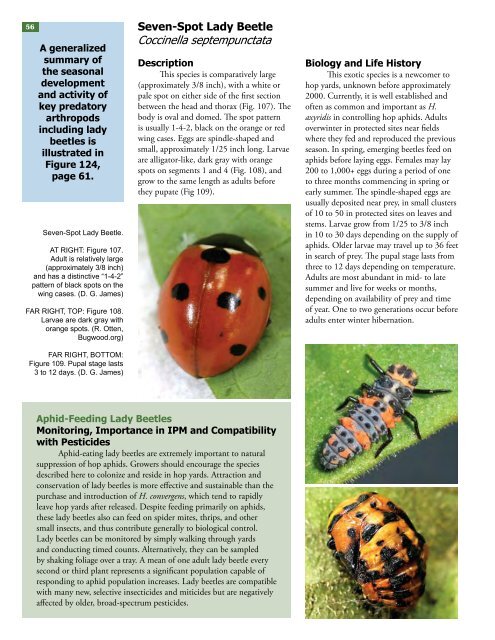Field Guide for Integrated Pest Management in Hops
Field Guide for Integrated Pest Management in Hops
Field Guide for Integrated Pest Management in Hops
You also want an ePaper? Increase the reach of your titles
YUMPU automatically turns print PDFs into web optimized ePapers that Google loves.
56A generalizedsummary ofthe seasonaldevelopmentand activity ofkey predatoryarthropods<strong>in</strong>clud<strong>in</strong>g ladybeetles isillustrated <strong>in</strong>Figure 124,page 61.Seven-Spot Lady Beetle.AT RIGHT: Figure 107.Adult is relatively large(approximately 3/8 <strong>in</strong>ch)and has a dist<strong>in</strong>ctive “1-4-2”pattern of black spots on thew<strong>in</strong>g cases. (D. G. James)FAR RIGHT, TOP: Figure 108.Larvae are dark gray withorange spots. (R. Otten,Bugwood.org)FAR RIGHT, BOTTOM:Figure 109. Pupal stage lasts3 to 12 days. (D. G. James)Seven-Spot Lady BeetleCocc<strong>in</strong>ella septempunctataDescriptionThis species is comparatively large(approximately 3/8 <strong>in</strong>ch), with a white orpale spot on either side of the first sectionbetween the head and thorax (Fig. 107). Thebody is oval and domed. The spot patternis usually 1-4-2, black on the orange or redw<strong>in</strong>g cases. Eggs are sp<strong>in</strong>dle-shaped andsmall, approximately 1/25 <strong>in</strong>ch long. Larvaeare alligator-like, dark gray with orangespots on segments 1 and 4 (Fig. 108), andgrow to the same length as adults be<strong>for</strong>ethey pupate (Fig 109).Biology and Life HistoryThis exotic species is a newcomer tohop yards, unknown be<strong>for</strong>e approximately2000. Currently, it is well established andoften as common and important as H.axyridis <strong>in</strong> controll<strong>in</strong>g hop aphids. Adultsoverw<strong>in</strong>ter <strong>in</strong> protected sites near fieldswhere they fed and reproduced the previousseason. In spr<strong>in</strong>g, emerg<strong>in</strong>g beetles feed onaphids be<strong>for</strong>e lay<strong>in</strong>g eggs. Females may lay200 to 1,000+ eggs dur<strong>in</strong>g a period of oneto three months commenc<strong>in</strong>g <strong>in</strong> spr<strong>in</strong>g orearly summer. The sp<strong>in</strong>dle-shaped eggs areusually deposited near prey, <strong>in</strong> small clustersof 10 to 50 <strong>in</strong> protected sites on leaves andstems. Larvae grow from 1/25 to 3/8 <strong>in</strong>ch<strong>in</strong> 10 to 30 days depend<strong>in</strong>g on the supply ofaphids. Older larvae may travel up to 36 feet<strong>in</strong> search of prey. The pupal stage lasts fromthree to 12 days depend<strong>in</strong>g on temperature.Adults are most abundant <strong>in</strong> mid- to latesummer and live <strong>for</strong> weeks or months,depend<strong>in</strong>g on availability of prey and timeof year. One to two generations occur be<strong>for</strong>eadults enter w<strong>in</strong>ter hibernation.Aphid-Feed<strong>in</strong>g Lady BeetlesMonitor<strong>in</strong>g, Importance <strong>in</strong> IPM and Compatibilitywith <strong>Pest</strong>icidesAphid-eat<strong>in</strong>g lady beetles are extremely important to naturalsuppression of hop aphids. Growers should encourage the speciesdescribed here to colonize and reside <strong>in</strong> hop yards. Attraction andconservation of lady beetles is more effective and susta<strong>in</strong>able than thepurchase and <strong>in</strong>troduction of H. convergens, which tend to rapidlyleave hop yards after released. Despite feed<strong>in</strong>g primarily on aphids,these lady beetles also can feed on spider mites, thrips, and othersmall <strong>in</strong>sects, and thus contribute generally to biological control.Lady beetles can be monitored by simply walk<strong>in</strong>g through yardsand conduct<strong>in</strong>g timed counts. Alternatively, they can be sampledby shak<strong>in</strong>g foliage over a tray. A mean of one adult lady beetle everysecond or third plant represents a significant population capable ofrespond<strong>in</strong>g to aphid population <strong>in</strong>creases. Lady beetles are compatiblewith many new, selective <strong>in</strong>secticides and miticides but are negativelyaffected by older, broad-spectrum pesticides.








